Invented by Michaela Kniessel, Christine Halleux, Shou-Ih Hu, Beate Diefenbach-Streiber, Josef Prassler, MORPHYSYS AG, Mereo Biopharma 3 Ltd
The market for polynucleotides that encode antibodies against sclerostin is expected to grow significantly in the coming years. According to a report by Grand View Research, the global market for sclerostin antibodies is expected to reach USD 4.3 billion by 2025, growing at a CAGR of 22.7% from 2018 to 2025. The increasing prevalence of bone-related diseases such as osteoporosis, coupled with the growing geriatric population, is expected to drive the demand for sclerostin antibodies.
Polynucleotides that encode antibodies against sclerostin have a wide range of potential uses. One of the most promising applications is in the treatment of osteoporosis. Osteoporosis is a condition that causes bones to become weak and brittle, increasing the risk of fractures. Current treatments for osteoporosis include bisphosphonates, hormone replacement therapy, and denosumab. However, these treatments have limitations, such as side effects and the need for frequent injections. Polynucleotides that encode antibodies against sclerostin offer a promising alternative, as they can be administered via a single injection and have fewer side effects.
Another potential use for polynucleotides that encode antibodies against sclerostin is in the treatment of bone metastases. Bone metastases occur when cancer cells spread to the bones from other parts of the body. This can cause pain, fractures, and other complications. Sclerostin antibodies have been shown to inhibit the growth of bone metastases in preclinical studies, making them a promising treatment option for this condition.
In addition to their therapeutic uses, polynucleotides that encode antibodies against sclerostin also have potential applications in research. Sclerostin antibodies can be used to study the Wnt signaling pathway and its role in bone growth and remodeling. They can also be used to develop new diagnostic tools for bone-related diseases.
In conclusion, the market for polynucleotides that encode antibodies against sclerostin is growing rapidly, driven by the increasing prevalence of bone-related diseases and the growing geriatric population. These antibodies have a wide range of potential uses, including the treatment of osteoporosis and bone metastases, as well as applications in research. As the demand for sclerostin antibodies continues to grow, we can expect to see continued innovation in this field, leading to new and improved treatments for bone-related diseases.
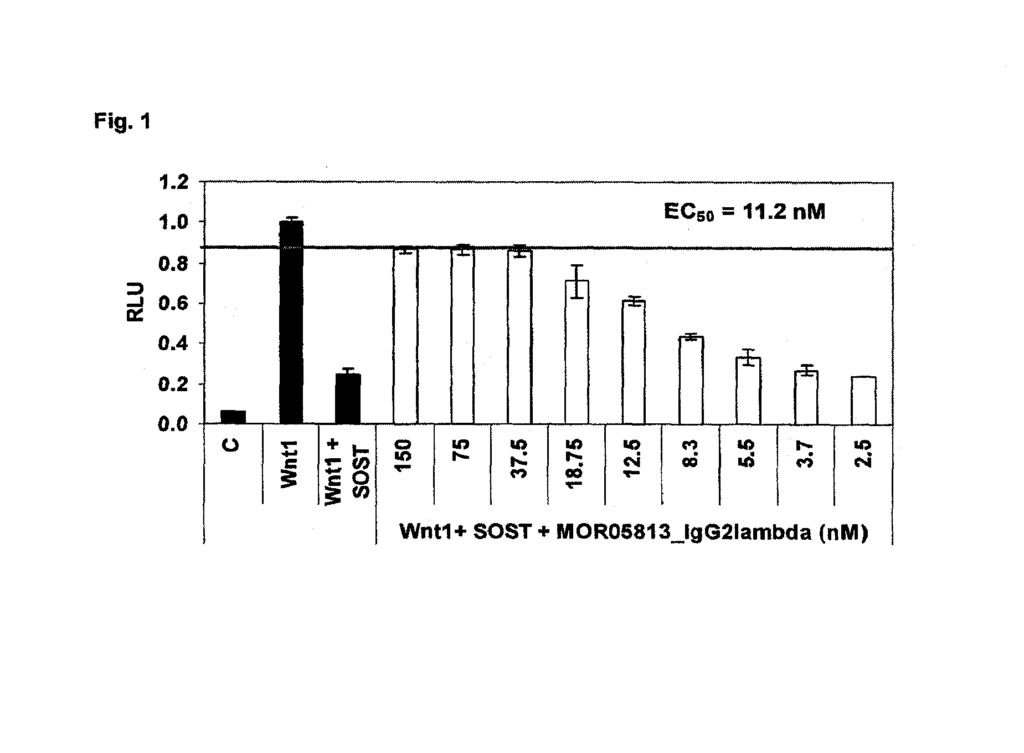
The MORPHYSYS AG, Mereo Biopharma 3 Ltd invention works as follows
The present invention is directed at antibodies against sclerostin, and to compositions and methods for using said antibodies in the treatment of a pathological condition that is caused by sclerostin. This can include diseases such as osteoporosis.
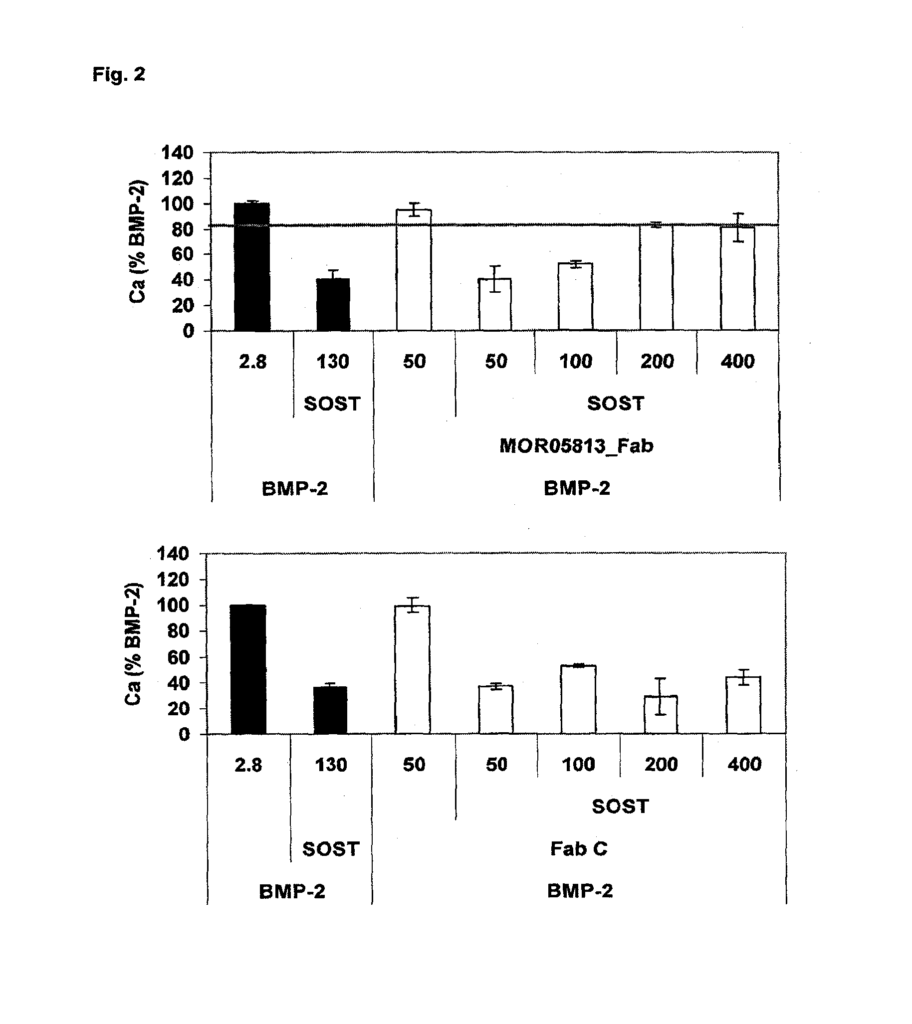
Background for Polynucleotides that encode antibodies against sclerostin, and their uses
The SOST gene codes for the secreted glycoprotein sclerostin, which has 213 amino acids. Sclerostin belongs to the superfamily of cystine knot-containing factors. Sclerostin belongs to the DAN/Cerberus family of proteins, which inhibits BMP signaling directly by blocking the binding of BMP receptors (Avsian, Kretchmer Mol Endocrinol 2004 18(1):1-12).
Sclerostin expression in adults is detected primarily in the kidney and bone.” Sclerostin is detected primarily in bone. It is only expressed in mature, terminally-differentiated bone-forming cells called osteocytes.
Sclerostin acts as a powerful negative regulator in the bone formation of men and mice. Sclerosteosis is caused by a lack of SOST expression (Balemans and al. Hum Mol. Genet., 2001, 10(5):537-43; Brunkow et al. Am J Hum Genet, 2001, 68(3):577-89). The patients have a lifelong overgrowth of bone, resulting in an increase in bone mineral density and bone strength. The patients do not have any other endocrinological disorders. All the complications that they suffer during their lifetime are due to an abnormal accumulation of bones. Heterozygous carrier of this recessive condition also show increased bone mass. J Clin Endocrinol Metab 2005, 90(12), 6392-5. SOST-deficient mice can recapitulate this phenotype, and its overexpression leads to osteopenia. Van Buchem [MIM 239100] – a phenotypic version of sclerosteosis – is caused by SOST malregulation due to genomic deletion of the long range bone enhancer. J Med Gene, 2002, 39(2):91-7; Loots et al., Genome Res, 2005, 15(7):928-35). Finaly, parathyroid hormone, a clinically validated principle of bone formation, is down-regulated during bone formation. This suggests that a part of PTH’s anabolic effect may be mediated by SOST.
Sclerostin can act as an antagonist to BMPs in vitro. EMBO J. 2003, 22(23), 6267-76. Sclerostin is also a negative regulator for canonical Wnt signals, either by binding directly to LRP5/LRP6 or indirectly (Li et. al. J Biol. Chem., 2005, 20; 280(20); Semenov, J Biol. Chem. 2006 Oct. 19; van Bezooijen et al. J Bone Miner Res. 2006, 10 October), or indirectly, (Winkler and al. J Biol. Chem., 2005, 28; 280(4):2498-502).
Lacking sclerostin results in increased bone formation while bone resorption remains unaffected (Sclerosteosis or Van Buchem Disease)” (Balemans and al. 2001; Brunkow et al. Am J Hum Genet, 2001, 68(3):577-89, Balemans et al. 2006; Loots et al., Genome Res, 2005, 15(7):928-35).
The current treatments available for skeletal disorders are primarily designed to inhibit further bone resorption, rather than stimulate new bone formation.
Estrogen is one example of a medication used to treat bone loss. It is unclear whether estrogen has long-term benefits. Estrogen may also increase the likelihood of breast and endometrial tumors. Bisphosphonates, statins (e.g. cinacalcet), calcilytics (e.g. olpadronate), calcimimetics, parathyroid hormones, strontium and lanthanum salts, sodium fluoride, calcilytics and calcimimetics are other current treatments for osteoporosis. These therapeutics are associated with unwanted side effects.
An embodiment hereof provides an antibody or functional proteins comprising an antigen binding portion of said antibodies for a target within sclerostin (SEQ ID No:155), characterized by the fact that the antibody/functional protein specifically binds sclerostin and can increase bone formation, mineral density, mineral content, mass, quality, and strength in a mouse.
In one embodiment, antibodies of the invention are able to reverse the sclerostin-induced inhibition of in vitro mineralization. In another embodiment, the antibodies have the ability of reverse sclerostin inhibitory effect on wnt-1-mediated signaling pathway. In a related embodiment, the antibodies disrupt sclerostin’s LRP6-binding and block sclerostin’s inhibitory effect at high doses of BMP-induced Smad1 phosphorylation. In another embodiment, antibodies of the invention bind a region of Sclerostin between the amino acids 112 to 126 inclusive. The region comprises amino acids 112 – 126 (SEQ ID No:155). The region comprises amino acids 160-174 from SEQ NO:155), and more specifically binds to a region that includes both ARLLPNAIGRGKWWR and RLVASCKCKRLTRFH.
Sclerostin inhibits the wnt1-mediated STF activation (Supertopflash reporter readout for canonical Wnt signaling), in HEK293 cell. The antibodies of the invention can restore the wnt reporter readout to a high reproducibility in some embodiments.
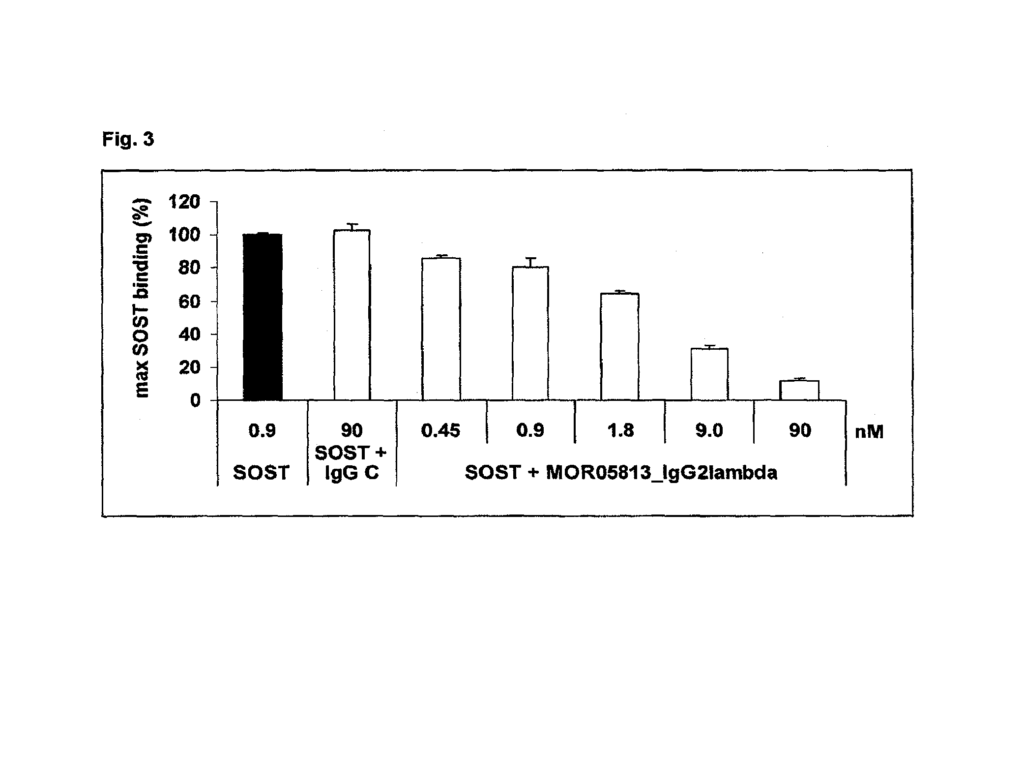
The observed inhibition of sclerostin in the Wnt reporter assay on non-osteoblastic cell lines has been shown in vivo to induce bone formation due to sclerostin inhibitory effects. In vivo studies in rodents aged over ten years show that antibodies according to this invention stimulate strong bone anabolism. The increase in bone mass reached the same effect as daily intermittent treatment of extremely high anabolic dosages of parathyroid hormonal (which was used to provide a positive control).
According to a preferred embodiment of the invention, antibodies have affinities for sclerostin that are in the low pM region and inhibit sclerostin’s impact on wnt signals with an IC50 value around 10 nM.
More preferentially, in another preferred implementation, the antibodies of the invention bind a region on sclerostin that is comprised of amino acids between 112 and inclusively 126 (i.e. The region comprises amino acids 112 – 126 in SEQ ID No:155 and amino acids 160 – 174 in SEQID NO:155. The region consists primarily of amino acids 161 to 174 (SEQ NO:155), and in particular, a region that overlaps the peptides RLVASCKCKRLTRFH and ARLLPNAIGRGKWWR, which have affinities for sclerostin at low pM levels and inhibit sclerostin’s impact on wnt signals with an IC50 of around 10 nM. These antibodies can increase bone mass of the mouse model’s axial and appendicular bones at the level of daily subcutaneous administration of an extremely high dose of parathyroid hormonal (positive control). They are useful for treating diseases related to abnormal bone growth, such as osteoporosis.
Further embodiments may include compositions containing the antibodies in combination with other therapies to treat osteoporosis such as parathyroid, LRP4 neutralising antibody, DKK-1 neutralising antibody, and parathyroid hormone.
The present invention is a series of isolated antibodies that are human, and specifically bind to sclerostin, and inhibit the functional properties sclerostin. In some embodiments, antibodies of the invention can be derived from specific heavy and light chains and/or have particular structural features like CDR regions containing particular amino acid sequences. The invention includes isolated antibodies, methods for making such antibodies as well as immunoconjugates, multivalent or multiple-specific molecules containing such antibodies. It also provides pharmaceutical compositions that contain the antibodies, the immunoconjugates, or the bispecific molecules. The invention also relates methods for using the antibodies to inhibit disorders or conditions associated with sclerostin, such as in the treatment of osteoporosis or other bone-related diseases.
To make the invention more easily understood, we first define certain terms. “The detailed description includes additional definitions.
The term “comprising” is used to describe a group of things. “The term?including? Included in the phrase “including” is the word “consisting”. e.g. A composition is a group of things. X can be made up of only X, or it may also include other things. X+Y.
The word “substantially” does not exclude “completely”. “The word?substantially? e.g. A composition that is “substantially free” A composition that is?substantially free? The word “substantially” may be used where necessary. The word “substantially” may be omitted when necessary from the invention’s definition.
Immune response” is a term that refers to the body’s immune system. “Immune response” refers to the actions of lymphocytes and antigen-presenting cells, phagocytic and granulocytes as well as soluble macromolecules (including antibodies, complement, cytokines and complement) that cause selective damage to, destruction or elimination of the human body of pathogens, cells and tissues infected by pathogens, cancerous or normal cells and tissues.
The term “sclerostin” refers to human SEQ ID No: 155. R&D Systems, Minneapolis, Minn. (USA) has recombinant human Sclerostin. R&D Systems, Minneapolis, Minn. (USA; 2006 cat#1589 ST-025), also offers recombinant mice sclerostin/SOST. U.S. Pat. Nos. “U.S. Patent Publications 2004,0009535, 20050106683 and 6,395,511 refer to anti-sclerostin antibody in general.
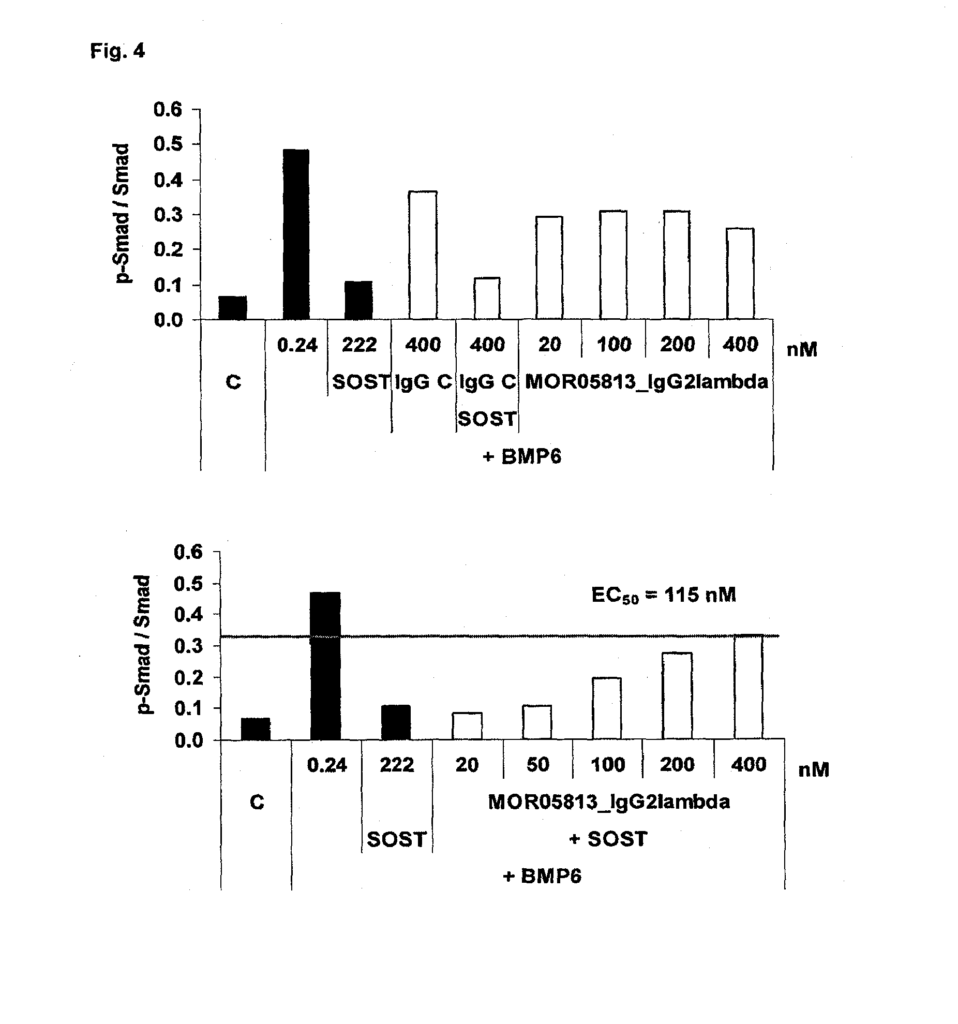
Click here to view the patent on Google Patents.
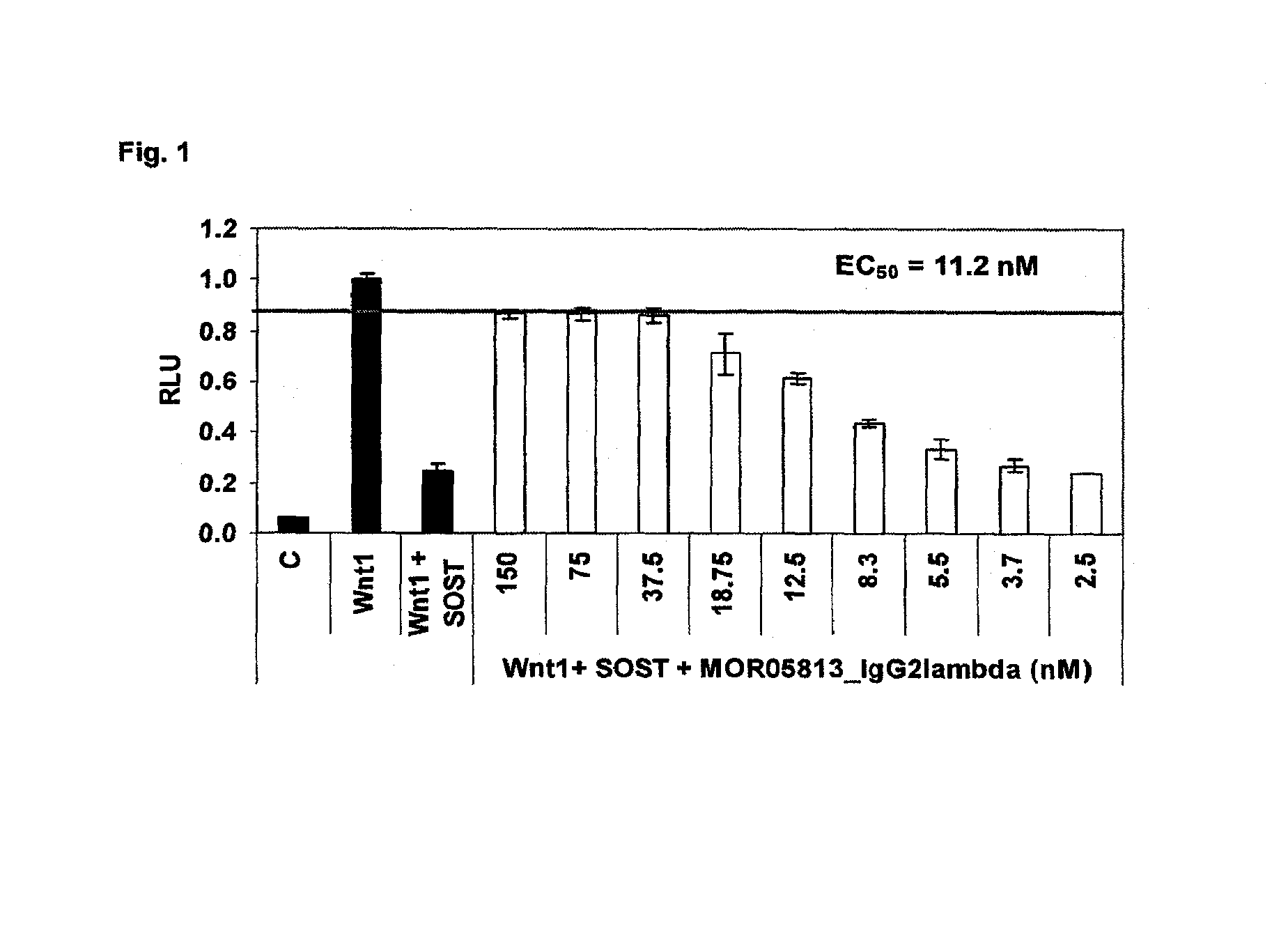
Leave a Reply